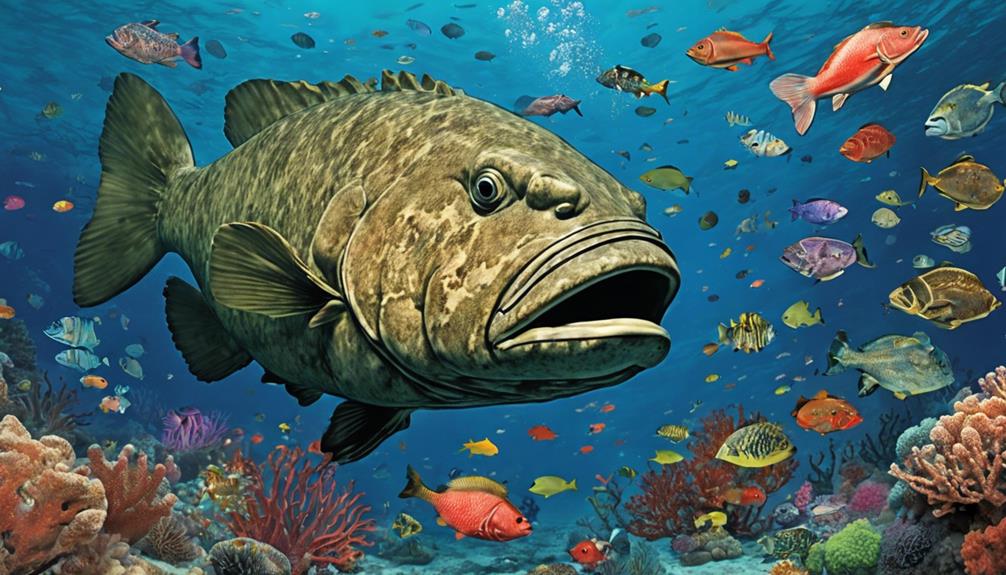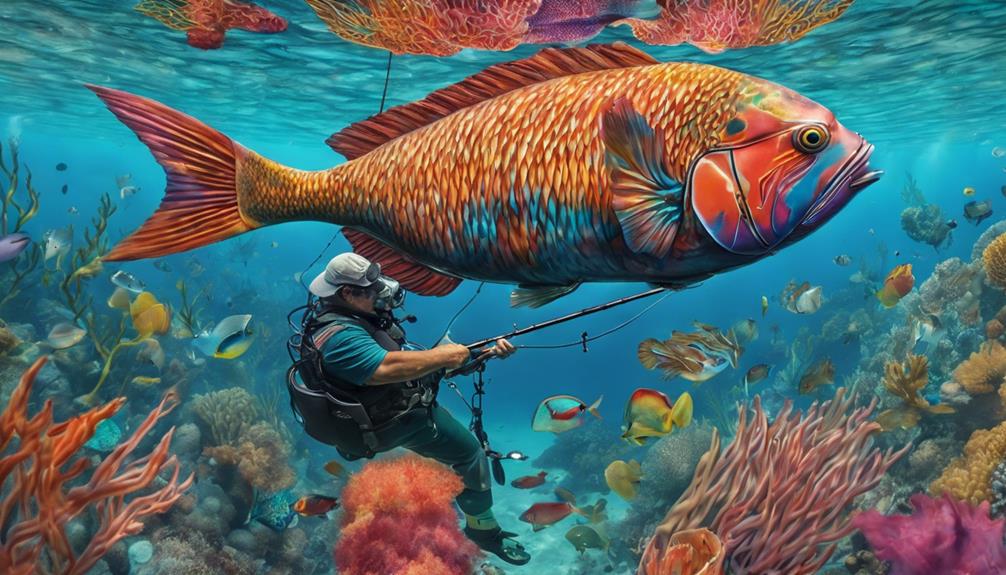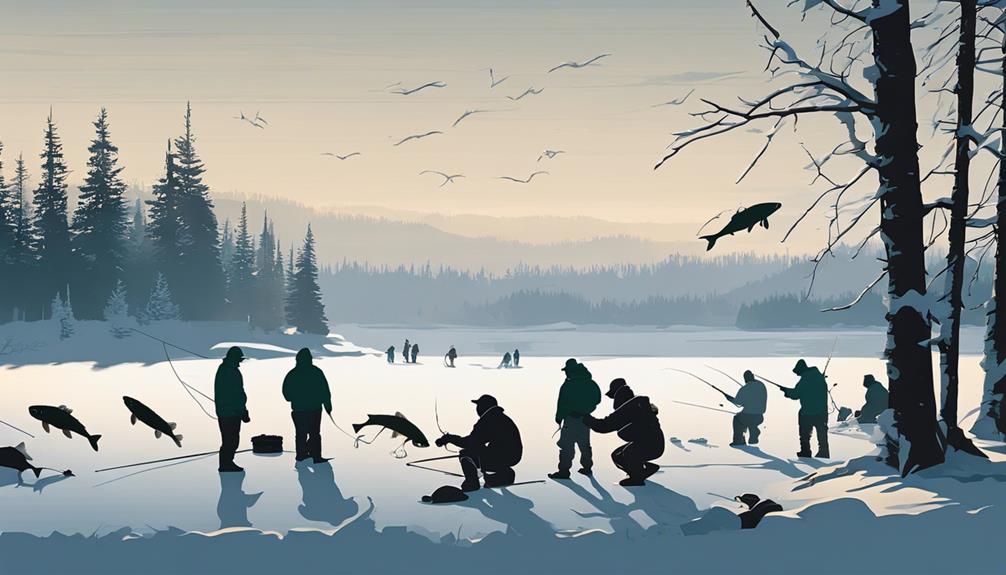Ever wondered how seasoned anglers target specific ocean species with precision?
From the elusive swordfish lurking in the depths to the acrobatic tarpon skimming the surface, each demands unique fishing techniques to secure a catch.
Delving into the world of specialized fishing methods for these ocean dwellers unveils a realm of strategy and skill that can elevate your angling game to new heights.
Explore the tailored approaches to hooking swordfish, marlin, mahi-mahi, tuna, shark, snapper, grouper, and tarpon, and discover the secrets that set successful anglers apart.
Swordfish: Deep-Sea Drifting Methods
Have you ever wondered how swordfish are caught using deep-sea drifting methods? Swordfish, elusive creatures of the deep, are often targeted using specialized techniques such as nighttime jigging and daytime drifting. When it comes to reeling in these majestic fish, anglers have the option of using either an electric reel or a manual reel.
For nighttime jigging, anglers typically use artificial lights to attract swordfish to the surface. Once the fish are in range, a jig is swiftly dropped and reeled back up in a jerking motion to entice a strike. This method requires precision and patience as swordfish are known for their powerful and swift movements.
During the day, swordfish are commonly caught using the drifting method. Anglers set up their lines with bait and let them drift naturally in the ocean currents. This technique requires a keen understanding of the ocean's movements and the behavior of swordfish.
When it comes to reeling in these powerful creatures, anglers have the choice between an electric reel and a manual reel. The electric reel offers convenience and ease of use, especially when dealing with large and powerful swordfish. On the other hand, the manual reel provides a more traditional and hands-on approach to fishing, requiring strength and endurance to bring in a catch. Both methods have their own set of challenges and rewards, adding to the thrill of swordfishing in the deep sea.
Marlin: Trolling Techniques for Big Game
Utilizing specialized trolling techniques is essential for targeting big game marlin in the open ocean. To enhance your chances of a successful catch, consider the following strategies:
- Live Baiting: Marlin are known to be attracted to live bait due to its natural movement and scent in the water. Utilize live bait such as small tuna, mackerel, or bonito to entice marlin effectively. Make sure the bait is lively and swims naturally to increase the chances of a marlin strike.
- High-Speed Trolling: Marlin are fast and aggressive predators, making high-speed trolling an effective technique. By moving at a faster pace, you can mimic the speed at which marlin hunt their prey, increasing the likelihood of a successful hookup. Use lures designed for high-speed trolling to match the pace of these powerful fish.
- Adjusting Depths: Marlin can be found at various depths in the ocean depending on factors like water temperature and available prey. Experiment with trolling at different depths using downriggers or diving planers to target marlin effectively at their preferred depth levels.
- Maintaining a Consistent Pace: When trolling for marlin, it's crucial to maintain a consistent pace to keep the lures moving naturally through the water. Avoid sudden speed changes or stops, as these can deter marlin from striking. Stay alert and focused on your trolling speed to optimize your chances of a marlin hookup.
Mahi-Mahi: Lure Selection and Retrieval
Selecting the appropriate lures and mastering retrieval techniques are crucial for targeting Mahi-Mahi effectively in the open ocean. When it comes to Mahi-Mahi, understanding their behavior is key to successful fishing. These vibrant fish are often found near underwater structures such as floating debris, weed lines, or buoys. To lure in Mahi-Mahi, consider using live baiting tactics like small fish or squid to mimic their natural prey.
Mahi-Mahi are known for their surface feeding patterns, where they tend to gather around floating objects or patches of seaweed. To capitalize on this behavior, choose lures that stay near the surface and create splashes or movements to attract their attention. In terms of weather conditions, Mahi-Mahi fishing is often more productive on sunny days with calm seas.
When retrieving your lure, use a varied technique that includes both fast and slow movements to mimic the erratic swimming patterns of Mahi-Mahi prey. Keep an eye out for any sudden changes in the behavior of the fish, as this may indicate they're about to strike. By adapting your retrieval speed and style to match the current conditions and the behavior of the Mahi-Mahi, you increase your chances of a successful catch.
Tuna: Chunking Chumming Approaches
To effectively attract and catch tuna, mastering chunking and chumming approaches is essential. When targeting these powerful fish, consider the following techniques:
- Tuna: Live Baiting Tactics: Utilize live bait such as small fish or squid to entice tuna. Make sure the bait is lively and moves naturally in the water to attract the attention of the tuna.
- Tuna: Surface Popper Techniques: Use surface poppers to create excitement and mimic baitfish movements. Cast the popper out and use a jerking motion to make it splash and create noise on the water's surface, attracting tuna.
- Tuna: Chumming Innovations: Experiment with different types of chum such as mashed sardines, fish oil, or even fish guts to create a scent trail that leads the tuna to your location. Chumming can significantly increase your chances of attracting tuna.
- Tuna: Topwater Excitement: Tuna are known for their aggressive topwater strikes. When using topwater lures, be prepared for explosive takes and fast-paced battles. Keep a tight line and be ready for the adrenaline rush of a tuna hitting your lure on the surface.
Shark: Baiting and Setting Lines
When baiting and setting lines for sharks, ensure your equipment is sturdy and your bait is fresh to maximize your chances of a successful catch. Sharks are attracted to scent, so using chumming tactics can be highly effective. Chumming involves dispersing a mixture of bait and fish oils to create a scent trail that lures sharks to your fishing area.
For baiting techniques, consider using fresh and oily fish such as mackerel, mullet, or bonito. These types of bait release a strong scent that can attract sharks from a distance. When setting your lines, make sure they're securely anchored and can withstand the strength of a shark. Sharks are known for their powerful and unpredictable movements, so having strong lines and hooks is crucial.
When baiting for sharks, it's important to be patient. Allow enough time for the scent of the chum to disperse and attract sharks to your area. Once you have a shark on the line, be prepared for a challenging battle. Sharks are strong and will put up a fight, so it's essential to remain focused and maintain control of the situation.
Snapper: Bottom Fishing Strategies
Ensure your bait is fresh and your gear is secure when bottom fishing for snapper to increase your chances of a successful catch. When targeting snapper, consider the following strategies:
- Snapper: Jigging Techniques: Snapper are known to be attracted to vertical movement. Jigging can be an effective method to entice snapper, especially when they aren't actively feeding near the bottom. Experiment with different jigging motions and speeds to find what works best in enticing these fish.
- Live Baiting Strategies: Using live bait can significantly increase your chances of attracting snapper. Live bait such as small fish or squid can be enticing to snapper due to the natural movements and scents they emit. Ensure your bait is lively and present it in a natural way to lure in these cautious fish.
- Snapper: Chumming for Success: Chumming involves dispersing small amounts of bait in the water to attract fish. Snapper are known to respond well to chumming. By creating a trail of scent and food particles in the water, you can draw snapper closer to your fishing spot, increasing your chances of a successful catch.
- Using Circle Hooks: When bottom fishing for snapper, using circle hooks can be beneficial. Circle hooks are designed to hook the fish in the corner of the mouth, reducing the likelihood of deep hooking and improving the chances of a safe release if the fish is undersized or not your target species.
Grouper: Wreck and Reef Fishing

For successful grouper fishing on wrecks and reefs, deploy sturdy gear and fresh bait to improve your chances of a rewarding catch. When targeting grouper using live baiting tactics, consider employing a large circle hook to prevent the fish from swallowing the bait completely, allowing for a better hook set. Wreck diving can be a thrilling way to locate grouper hiding in the depths, but remember to exercise caution and prioritize safety at all times.
Jigging techniques are effective for grouper fishing around reef structures. Try using heavy jigs that can reach the bottom quickly where grouper tend to lurk. Vary your jigging motion to entice strikes from these elusive fish. Before heading out to sea, invest time in reef structure mapping to pinpoint potential grouper hotspots. Look for ledges, rock formations, and underwater caves where grouper are known to congregate.
Tarpon: Fly Fishing Tips and Tricks
To enhance your success in targeting tarpon through fly fishing, adapt your techniques to match the agility and strength of these acrobatic ocean predators. When fly fishing for tarpon, consider the following tips and tricks:
- Casting Accuracy: Tarpon are known for their elusive nature, so honing your casting accuracy is crucial. Practice casting at different distances and angles to prepare for real-life scenarios when targeting these fast-moving fish.
- Line Control: Tarpon are powerful fighters and can make long runs, so maintaining control over your line is essential. Be ready to strip or reel in line quickly to keep tension on the fish and prevent it from escaping.
- Rod Selection: Opt for a strong and flexible rod when targeting tarpon. A fast-action rod with a heavy weight capacity is recommended to handle the strength and acrobatics of tarpon effectively.
- Fighting Techniques: When hooked, tarpon are known for their aerial displays and strong runs. Use proper fighting techniques such as keeping your rod tip up to prevent the line from getting caught on underwater obstacles and tire out the fish gradually to bring it to shore.
Frequently Asked Questions
What Is the Best Time of Day to Target Swordfish Using Deep-Sea Drifting Methods?
When targeting swordfish using deep-sea drifting methods, the best time of day is nighttime. Swordfish are more active during the night, making it the optimal time for fishing success.
Remember to adjust your drifting depth accordingly to increase your chances of catching swordfish. Stay patient and alert during the dark hours for a successful fishing expedition.
How Can Anglers Ensure They Are Using the Correct Trolling Speed for Targeting Marlin With Trolling Techniques?
To nail the right trolling speed for marlin, watch fish behavior closely. Quick marlins like fast-moving prey, so speed up if they're around. Slow down if they seem hesitant.
Lure selection's key too. Flashy, large lures mimic their favorite meals. Experiment with different speeds and lures until you find what hooks them best.
Stay observant and adaptable to reel in those majestic marlins successfully.
Are There Specific Water Conditions That Are More Favorable for Attracting Mahi-Mahi When Selecting Lures and Retrieving Them?
When targeting mahi-mahi, consider the water conditions that attract them. Current patterns and temperature variations play a crucial role.
Optimal conditions include warmer water and spots with strong currents. Focus on bait selection and hook placement to entice these vibrant fish. Experiment with different lures and retrieval speeds to find what works best.
Pay attention to where schools of baitfish gather, as mahi-mahi are often found nearby.
What Type of Chum Is Most Effective for Attracting Tuna When Using Chunking Chumming Approaches?
When targeting tuna using chunking chumming approaches, the most effective chum is one that's oily and has a strong scent to attract the fish. Tuna are drawn to the scent and oils in the water, so using oily fish-based chum or even fish blood can be highly effective.
Experiment with different types of chum and see what works best to lure in those tuna.
Alternative baits can also be successful in enticing tuna to bite.
How Can Anglers Avoid Attracting Unwanted Shark Species When Baiting and Setting Lines for Targeted Shark Fishing?
To avoid attracting unwanted shark species when baiting and setting lines for targeted shark fishing, try using shark deterrents and bait alternatives.
Adjust your line depth and drift patterns to target specific shark species while avoiding others.
Conclusion
You've learned some specialized fishing techniques for unique ocean species. Whether you're deep-sea drifting for swordfish or trolling for marlin, it's all about selecting the right gear and using the right techniques.
Remember to be patient, stay focused, and enjoy the thrill of the catch. So grab your rod, head out to the open waters, and put your newfound skills to the test.
Happy fishing!



